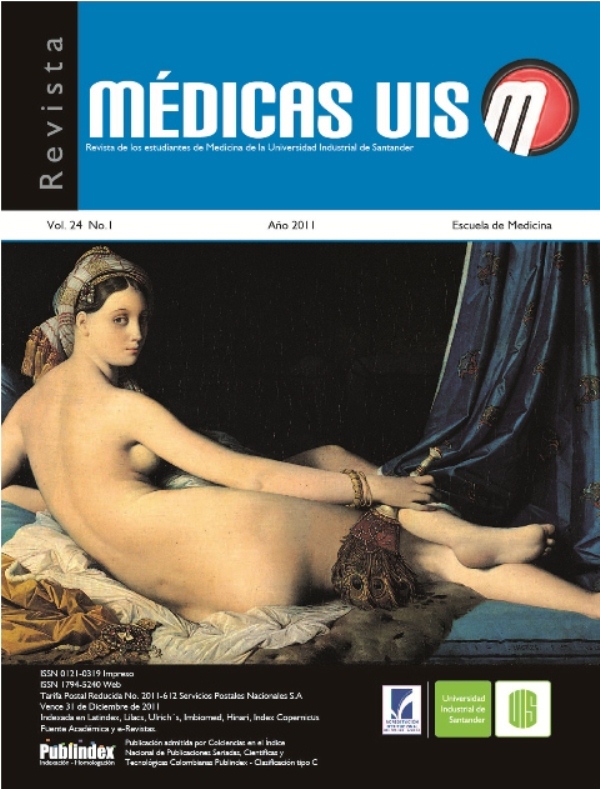Abstract
Does it exist any relation between extension of corporal surface burns and percentage of survival and mortality in adultand pediatric patients?Burns injuries have become an increasing cause of morbidity and mortality, reporting in Latin America an average of 1351cases of burn injuries each year, requiring hospitalization and causing about 23 deaths per year. In Colombia, the mostaffected population, according to a report of cases, are children between one and four years old, usually making withfollowing complications due to the seriousness of the injury and even death. Studies suggest a relationship between the bodysurface involved, localization, age and risk mortality. Currently is suggested the direct relationship between genetic riskfactors such as the CD14 polymorphism and risk of mortality in individuals. A case of a two years old girl is presented, whoconsulted the health center with severe burns with commitment of the 71% of total body surface area, with high risk ofmortality and complications. Appropriate management is provided and it is obtained satisfactory outcome. That caseconcerned about the factors that influenced this happy ending, reason why this literature review was made.
Keywords. Burns. Genetic polymorphism. Antigens CD14. Child mortality.
References
2. Hoyos M, Gonzales N, Díaz M, Pardo S, Ospina S. Epidemiological and clinical profile of burn victims, Hospital Universitario San Vicente de Paúl, Medellín, 1994-2004. Burns 2006;32:1044-51.
3. Spanholtz T, Panagiotis T, Peymaneh A, Gerald S.. Severe Burn Injuries Acute and Long-Term Treatment. Deutsches Ärzteblatt Internationa 2009;106(38):607–13.
4. Cardona F, Echeverri A, Forero J, García A, Gómez C, Mahecha D, et al. Epidemiología del trauma por quemaduras en la población atendida en un Hospital Infantil. Manizales (Colombia). Rev fac med unal 2007;55(2).
5. Lessa J, Santos J. Predictive factors of mortality in burn patients. Rev. Inst. Med. trop. S. Paulo 2007 49(6):365-70.
6. Ferj D. Quemaduras en edad pediátrica: enfrentamiento inicial. Departamento Cirugía Infantil y Neonatal. Clínica Las Condes. Jefe de la Unidad de Quemados Hospital Luis Calvo Mackenna. Rev med clin condes 2009;20(6):849-59.
7. Bracho F. La Respuesta Inmunológica a las Quemaduras. MEDICRIT 2005;2(2):17-20.
8. Akita S, Nakagawa H, Tanaka K, Hirano A. Analysis of pediatric burns in Nagasaki University from 1983 to 2002. Division of Plastic and Reconstructive Surgery. Department of Developmental and Reconstructive Medicine. Nagasaki University, Graduate School of Biomedical and Sciences, 1-7-1 Sakamoto, Nagasaki 852, Japan Burns, 2005;31:1041–4.
9. Shalhub S, Tam P, Gibran N, Grant E,. Tumor Necrosis Factor Gene Variation and the Risk of Mortality After Burn Injury: A Cohort Study. Journal of Burn, Care 2009.
10. Barber R, Aragaki C, Ling-Yu E, Purdue G, Hunt J, Brett A, et al. Cd14-159 c allele is associated with increased risk of mortality after burn injury. SHOCK 2007;27(3):232-7.
11. Barber RC, Chang LY, Arnoldo BD, Purdue GF, Hunt JL, Horton JW, et al. Innate Immunity SNPs are Associated with Risk for Severe Sepsis after Burn Injury. University of Texas Southwestern Medical Center, Department of Surgery, Dallas. Clin Med Res. 2006;4,(4):250-5.
12. Shalhub S, Junker C, Imahara S, Mindrinos M, Dissanaike S, O’Keefe G. Variation in the TLR4 gene influences the risk of organ failure and shock post-trauma: a cohort study. J Trauma, 2009 January;66(1):115-23.
13. Lin J, Yao Y, Huang Z, Yu Y, Zhu J, Chai J, et al. The influence of CD14 genomic polymorphism on CD14 gene expression as well as protein release and its clinical significance in patients with extensive burns. Zhonghua Wai Ke Za Zhi. 2006 Jul 1;44(13):907-10.
14. Barber R, Chang LY, Lemaire SM, Burris A, Purdue GF, Hunt JL, et al. Epistatic interactions are critical to gene-association studies: PAI-1 and risk for mortality after burn injury. J Burn Care Res. 2008 Jan-Feb;29(1):168-75.
15. Barber R, Ling-Yu E, Arnoldo B, Purdue G, Hunt J, Horton J, et al. Innate Immunity SNPs are Associated with Risk for Severe Sepsis after Burn Injury. Clinical Medicine & Research 2006;4(4):250-5.
